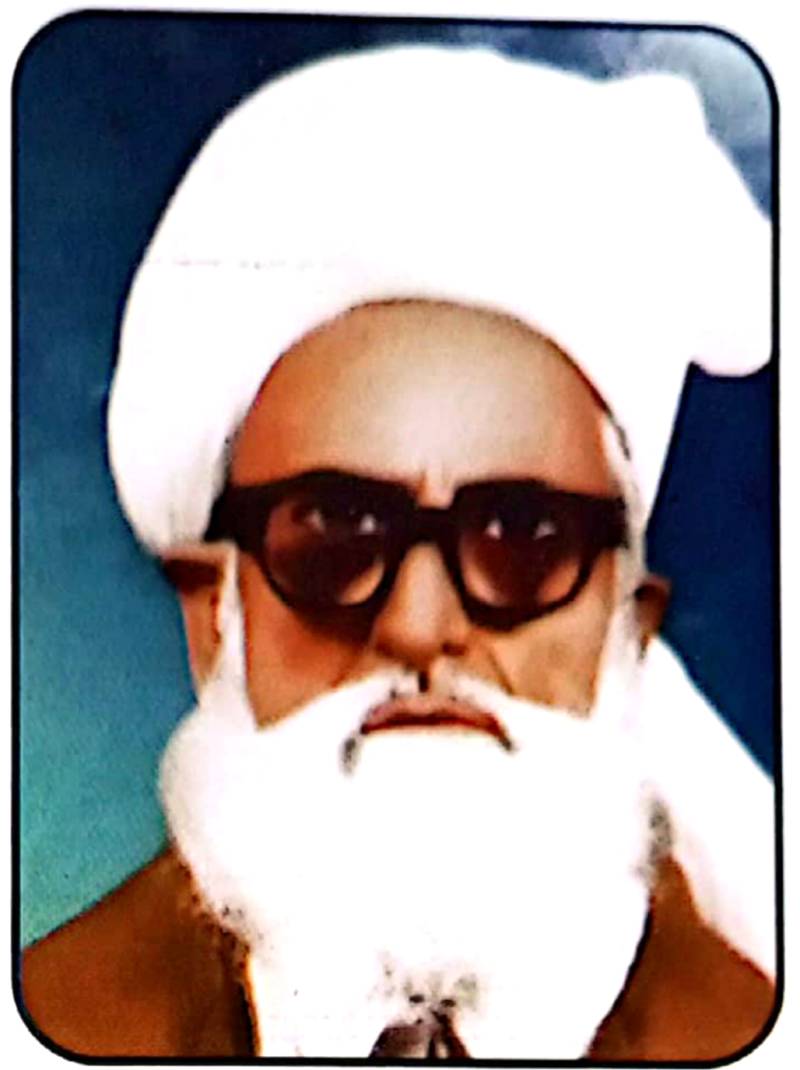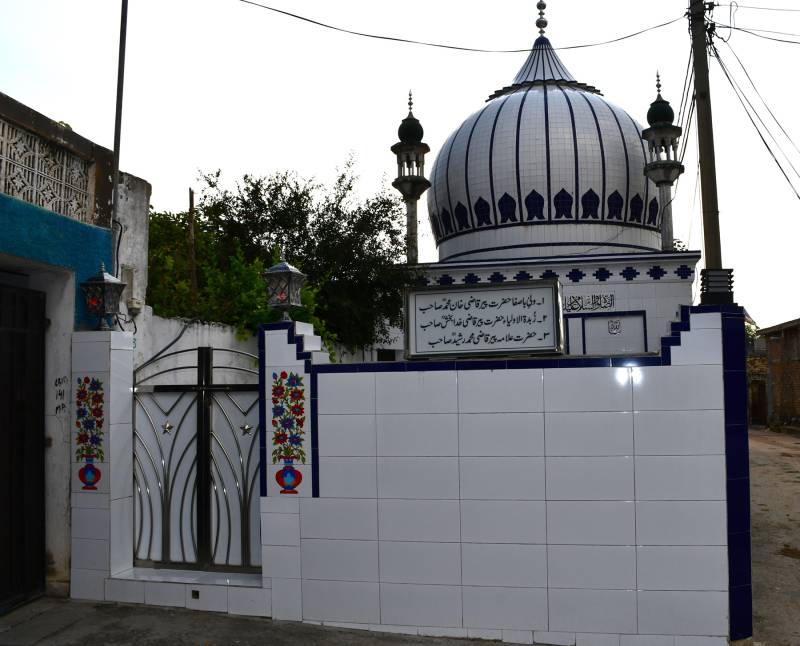
Gujar Khan tehsil is known for its numerous shrines dedicated to Chishti saints, which can be found throughout the area. Two notable Chishti Sufi saints, Khwaja Maulana Muhammad Hussain Chishti Hyderi and Khwaja Khan Muhammad Chishti, were deputies (Khulfa) of Khwaja Pir Syed Ghulam Hyder Ali Shah Jalalpuri from Gujar Khan. Khwaja Pir Syed Ghulam Hyder Ali Shah was the deputy of Khwaja Shamsuddin alias Pir Sial (d 1883), who was himself deputy of Khwaja Shah Muhammad Suleiman Taunsvi alias Pir Pathan (d 1850).
The tomb of Khwaja Pir Syed Ghulam Hyder Ali Shah is located in Jalalpur Sharif in the Jhelum district. It is one of the most remarkable tombs in the Punjab province, whose construction started in 1908 and was completed in 1918. This tomb is distinguished by its grand scale and the presence of magnificent mural paintings, ornately carved doors and aesthetic ornamentation, which are not found in any other tomb in the Jhelum district. I had the opportunity to visit Jalalpur Sharif twice: first in 2019 and then in 2023.

According to Hasan Nawaz Shah (2013:39), Maulana Muhammad Hussain Chishti Hyderi and Qazi Khan Muhammad Chishti were two eminent deputies of Khwaja Pir Syed Ghulam Hyder Ali Shah Jalalpuri from Gujar Khan tehsil who played an important role in preaching Chishtiyya Silsila. In his forthcoming book Tazkira e Ulama-e Gujar Khan, he notes that Maulana Muhammad Hussain Chishti Hyderi (d 1953) hailed from the village of Bunair Kaswal near Jabbar. He was also a Punjabi poet. Hasan Nawaz Shah states that his poetry collection, Gulzar-e-Hyderi, was published three times during his lifetime. Additionally, his other works were also published during his lifetime.

The shrine of the other khalifa of Khwaja Pir Syed Ghulam Hyder Ali Shah Jalalpuri from Gujar Khan tehsil, Qazi Khan Muhammad Chishti, is located in Mohra Amin village. Mohra Amin, a small village in the Jhungal Union Council of Gujar Khan, is located about 6 kilometres west of Bhair Ratial village. Bhair Ratial is situated on the Mandra-Chakwal Road and is an important village in the Gujar Khan Tehsil.
Qazi Khan Muhammad Chishti was a resident of Mohra Khairu village. This village is located near Gorsian village and about 5 km from Sud Stop on Mandra-Chakwal Road. I went there once while visiting the shrine of Molvi Shah Nawaz (d 1929) in Gorsian village. Molvi Shah Nawaz was a disciple of Khwaja Ahmad Mairvi (d 1911) and a deputy of Khwaja Amir Ahmad Basalvi (d 1939).
We find a tomb on a grand scale and magnificent mural paintings, together with ornately carved doors and aesthetic ornamentation, which are not found in any other tomb in the Jhelum district
At the request of the residents of Mohra Amin, Qazi Khan Muhammad moved from Mohra Khairu to Mohra Amin to lead prayers in the village mosque. He also began teaching students at the village mosque. It is said that he eventually settled in Mohra Amin permanently. Later, he started visiting Jalalpur Sharif and became a deputy of Khwaja Pir Syed Ghulam Hyder Ali Shah Jalalpuri. After receiving a robe of initiation (khirqa) from Khwaja Pir Syed Ghulam Hyder Ali Shah into the Chishti Silsila, he transformed Mohra Amin into a thriving centre for the Chishti order. During this period, many people began to visit Qazi Khan Muhammad Chishti.

Haji Muhammad Murid Ahmad Chishti (2010: 460-61) mentions in Fauz al Maqal Fi Khulfa-e-Pir Sial that Qazi Khan Muhammad Chishti frequently visited Jalalpur Sharif. On his way to Jalalpur Sharif, he often stayed in Narali village with Bhag Khan, who was also a deputy of Khwaja Pir Syed Ghulam Hyder Ali Shah. According to Haji Muhammad Murid Ahmad Chishti (2010:461), many people became his disciples. One prominent disciple of Qazi Khan Muhammad Chishti, Mian Mardan Ali, was a resident of the Majisd Alam locality in Rawalpindi and a poet who composed verses praising his spiritual mentor. Qazi Khan Muhammad Chishti was also a Punjabi poet.
Qazi Khan Muhammad Chishti devoted much of his time to preaching the Chishtiyya Silsila in his village and the surrounding areas, attracting many followers to his teachings. After the death of his spiritual master, Khwaja Pir Syed Ghulam Hyder Ali Shah Jalalpuri, in 1908, his son Khwaja Syed Muzaffar Ali Shah Jalalpuri succeeded him as the first Sajjada Nashin of the Darbar. He held Qazi Khan Muhammad Chishti in high regard. Following the death of Khwaja Syed Muzaffar Ali Shah in 1926, Amir-e-Hizbullah Syed Muhammad Fazal Shah Jalalpuri became the Sajjada Nashin of the Darbar of Khwaja Pir Syed Ghulam Hyder Ali Shah. It is said that during the visit of Amir-e- Hizbullah Syed Muhammad Fazal Shah (d 1966) to Mohra Amin, Qazi Khan Muhammad Chishti had grown old by that time.

Qazi Khan Muhammad Chishti died in 1932. He had two sons, Ghulam Ganj Shakar and Qazi Khuda Bakhsh Chishti. Ghulam Ganj Shakar died at a young age, while Qazi Khuda Bakhsh Chishti continued his father's spiritual legacy. He was a learned scholar of hadith and Fiqah and an eminent Chishti Sufi. According to Qazi Muhammad Saeed, the Sajjada Nashin of Qazi Khan Muhammad Chishti Darbar, Qazi Khuda Bakhsh was initiated into Chishti Silsila by Amir-e-Hizbullah Syed Muhammad Fazal Shah Jalalpuri, who founded Hizbullah Movement in 1927. He was the second Sajjada Nashin of Khwaja Syed Ghulam Hyder Ali Shah Darbar. During my visit to Mohra Amin, I had a detailed interview with Qazi Saeed Muhammad Chishti about his ancestors and their spiritual connection to the Darbar of Khwaja Pir Syed Ghulam Hyder Ali Shah Jalalpuri.

Qazi Khuda Bakhsh died in 2004 and was succeeded by his son Qazi Muhammad Rasheed. Qazi Muhammad Rasheed was also known for his piety. He was a poet of Urdu and Punjabi. His two books have been published. His third published book, Tazkira Khwajgan-e-Mohra Amin, presents hagiographical accounts of Qazi Khan Muhammad Chishti and Qazi Khuda Bakhsh Chishti. It was posthumously published in 2024. His son, Qazi Muhammad Saeed Chishti, published this book. In this book, he discusses the miracles associated with Qazi Khan Muhammad Chishti. One also learns the names of the disciples of Qazi Khan Muhammad Chishti from this book. Qazi Muhammad Rasheed died in 2018, leaving behind three sons, Qazi Muhammad Saeed, Qazi Muhammad Saqib Rasheed and Ajmal Rasheed.
The tomb of Qazi Khan Muhammad is located in the heart of Mohra Amin village. We find that the tomb over the grave of Qazi Khan Muhammad Chishti was constructed in 1976. Inside the tomb are three graves belonging to Qazi Khan Muhammad Chishti and his sons, Ghulam Ganj Shakar and Qazi Khuda Bakhsh. Qazi Muhammad Rasheed's grave is next to the tomb of Qazi Khan Muhammad Chishti.

This tomb is built in a square plan with a hemispherical dome with two turrets rising from the parapet of the structure, a feature which was commonly used in tomb building in the 20th century in Pothohar. The interior of the tomb is octagonal. The tomb features ceramics, and its floor is also adorned, creating a sparkling appearance.
Two Urs are held at the shrine of Qazi Khan Muhammad Chishti in February and June every year. During these occasions, devotees from the Pothohar Plateau and the Salt Range in Punjab gather at the shrine of Qazi Khan Muhammad Chishti.

